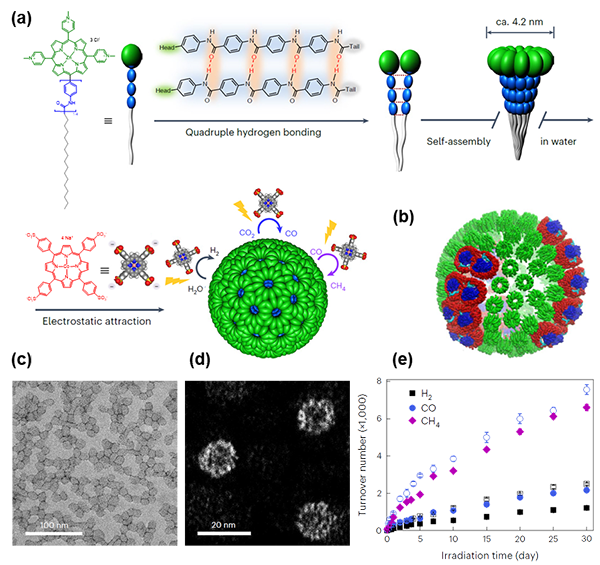Photosynthesis provides nearly all living organisms the ultimate source of energy and organic substances. In nature, photosynthetic organelles harness solar radiation to produce energy-rich compounds from water and atmospheric CO2 via exquisite supramolecular assemblies. Although artificial photocatalytic cycles have been shown to occur at higher intrinsic efficiencies, the low selectivity and stability in water for multi-electron CO2 reduction hamper their practical applications. The creation of water-compatible artificial photocatalytic systems mimicking the natural photosynthetic apparatus for selective and efficient solar fuel production represents a major challenge.
On May 18th, 2023, Prof. TIAN Jia from the Shanghai Institute of Organic Chemistry at the Chinese Academy of Sciences published a paper in Nature Catalysis titled "Artificial spherical chromatophore nanomicelles for selective CO2 reduction in water" (Nat. Catal. 2023, https://doi.org/10.1038/s41929-023-00962-z). The team developed a new strategy for visible-light-induced selective CO2 conversion by mimicking the key elements and assembly structures of natural photosynthetic purple bacteria chromatophores through supramolecular self-assembly. This work provides novel insights for accurately simulating biological structures and functions of supramolecular assemblies and energy conversion for artificial photosynthesis.
A supramolecular assembly approach was used to create an artificial photosynthetic chromatophore nanomicelle system based on the structure of natural photosynthetic purple bacteria. The system was applied to selective CO2 catalytic conversion in water under visible light irradiation and showed excellent stability and efficiency. The research provides a promising solution for energy conversion and storage through "zero-carbon cycle" pathways, which is an effective way to alleviate energy crises and reduce carbon emissions.
Benefit from the existence of intermolecular hydrogen bonds, the as-prepared spherical nanomicelles assembled from amphiphilic tri-block porphyrin-based supramolecules are extremely stable in aqueous phase. As chromatophore, the nanomicelles exhibited obvious light-harvesting antenna effect and strong resistance against photobleaching. Besides, electropositive ring-like porphyrin arrays of 4.2 nm in diameter were observed on its surface and each sub-structure consists of ca. 12 porphyrin by calculation. For the purpose of efficient electron injection, electronegative Co catalyst was chosen as ideal catalyst because the space distance between the catalyst and the ring-like porphyrin array was drawn closer by electrostatic force. Under the irradiation of visible light (Xe lamp, AM 1.5 G, λ > 420 nm), the artificial photocatalytic system achieved the conversion of CO2 to CH4 in a high efficiency and selectivity. Specifically, the apparent quantum efficiency measured at 450 nm was determined to be 15.2% in the initial 2 hours and the turnover number was over 6,600 with electron selectivity over 89% in 30 days. At last, a two-stage mechanism in which CO was regarded as intermediate species was proposed and further proved by isotope labeling experiment, steady-state and transient absorption spectra and DFT calculations.

Figure 1. Self-assembly of artificial spherical chromatophore nanomicelles for selective CO2 reduction in water. (a) Chemical structures and assembly pathway. (b) Structure of the natural spherical chromatophore vesicle of R. sphaeroides, (c-d) Characterizations of the self-assembled structures of the nanomicelles, (e) The photocatalytic performance in 30 days.(Image by Nature Publishing Group)
TIAN Jia Ph.D.Professor
Key Laboratory of Synthetic and Self-Assembly Chemistry for Organic Functional Molecules, Center for Excellence in Molecular Synthesis, Shanghai Institute of Organic Chemistry, Chinese Academy of Sciences
Ling Ling Road 345 Shanghai 200032 China
Tel: 0086-21-54925619
Email: tianjia@sioc.ac.cn


